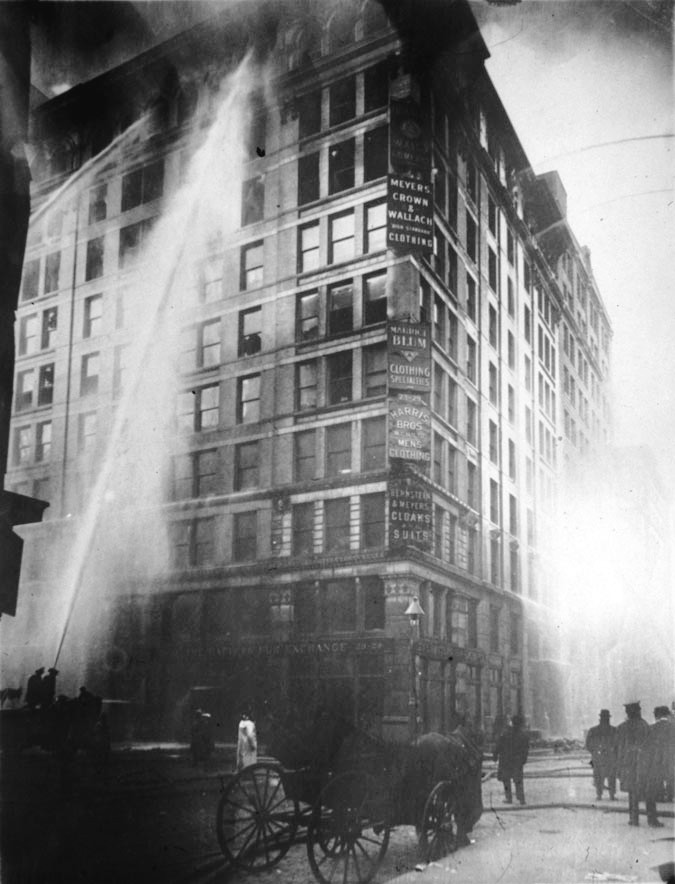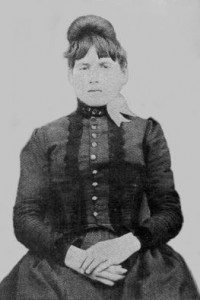It was March 25, 1911, in New York City. It was a Saturday afternoon just like any other at the Triangle Shirtwaist factory, where young immigrant women sat in front of sewing machines, day in and day out, sewing. But on that day a fire broke out, causing the deaths of 146 garment workers. Among those who died in the flames and smoke were 123 women and 23 men.1 Many even jumped or fell to their deaths out the windows, making this event a man-made disaster and one of the deadliest industrial disasters of all time.

The factory was located in the Asch Building at Washington Place in Greenwich Village, one of the wealthiest neighborhoods in the city. The factory occupied the eighth, ninth, and tenth floors of the ten-story building. Max Blanck and Issac Harris were the owners of the factory, and their company was known as the largest firm in the business at the time. They styled women’s blouses known as “Shirtwaists,” which were paired with tailored skirts. This attire had become the standard in fashion for women in the early twentieth century. They were also known to resemble men’s shirts. When it came to their workers, they had hired operators who then contracted out for factory workers. The company itself only dealt with the contractors, and there was no fixed rate of pay for the workers.2 At the time, the factory employed about five-hundred employees, mostly young immigrant women who were of Italian or Jewish descent. These women worked up to eleven-hour shifts on weekdays, and twelve-hour shifts on Saturdays, and they earned between $7-$12 dollars for a 52-hour week. Many of these women were the breadwinners of their household, and their income was sometimes not sufficient to cover their needs.
Towards the end of the workday on that Saturday evening in 1911, a fire broke out around 4:00 pm. The fire started in a scrap bin under one of the cutter’s tables on the eighth floor from what is believed to have come from a cigarette. A manager tried to put the fire out with a hose but the hoses valve was rusted shut, and rotten away. The fire spread quickly and the workers panicked. There was one fire escape that quickly collapsed, and four elevators, which out of the four only one was working. The elevator held twelve people at a time, and it managed to make four rescue trips before it broke down.3 With no other alternatives available, people began throwing themselves out the windows, and some were even crushed to death trying to get out. Workers tried to take the stairs, but the exit doors only opened inward and were kept locked by factory management to prevent theft by the workers, as the managers would check their workers belongings every day before they left for the day.

Celia Saltz Pollack, a survivor of the 1911 Triangle Shirtwaist Fire said,
I remember on that day there was a lot of singing and happiness in the shop because it was the end of the week and we got paid. We were soon all going to go home. When the fire started I was sitting at my machine. I looked up and saw the fire near the cutting tables but I did not think it was so terrible. What was terrible was that the fire spread in a split second.
By the time the firefighters arrived, they came to the realization that their ladders could only extend up to the sixth or seventh floors. With no other option, sixty-two workers jumped and fell to their deaths, while the remaining died from the smoke and flames within the building.4

This fire not only pushed issues of unsafe factories and immigrant exploitation into the public consciousness, but for the first time the fire allowed for attention to be brought to deplorable conditions of New York factories.5 Women obtained well deserved attention onto current work conditions and safety measures in the workplace. Although the Triangle Shirtwaist Factory fire brought a feeling of resentment and heartbreak to many, this event and its victims will always be remembered.
- Ric Burns, “Triangle Shirtwaist Fire,” New York Times (1923-Current File), Nov 24, 1999. ↵
- Jonathan Fink, “Conflagration and Wage: The Triangle Shirtwaist Factory Fire, 1911,” TriQuarterly, no, (2009): 135-136. ↵
- Gale Encyclopedia of U.S. Economic History, s.v. “Triangle Shirtwaist Fire,” by Thomas Carson and Mary Bonk. ↵
- Mia Lynn Mercurio, Régine Randall, “Tributes Beyond Words: Art Educators’ Use of Textiles to Memorialize the Triangle Shirtwaist Factory Fire.” Journal for Learning through the Arts no. 1 (2016): 4-5. ↵
- Albert Marrin, Flesh and blood so cheap: The Triangle fire and its legacy (New York: Alfred A. Knopf, 2011), 23-25. ↵




135 comments
Elizabeth Guardiola
I remember learning about this Shirtwaist factory fire many years ago in a history class and was astounded by the results of the incident. The quote by a fire survivor gives insight into what those ladies (and men) felt that day it is so sad. They did not expect it and were unable to prevent nor control it. One second, everyone was happy and their day was going like any other day, the next second women are jumping out of windows. it is sad to see this is what it took to realize the dangers of a hazardous work environment.
Celeste Flores
I had already heard about the tragedy because they did a play at STMU about it. However, I did not know the full details and now I understand it better. It is extremely unfortunate that so many people lost their lives due to poor and unsafe conditions. I cannot even imagine what would it be like to choose in between dying in a painful way or jumping out of a window. Having a factory with that amount of workers is a very big responsibility, as owners/CEO’s they should ensure and prioritize their worker’s safety.
Kenneth Gilley
While I had heard of the Triangle Shirtwaist fire before, I did not know the details of what happened. The choice between being burned alive and jumping seven or eight stories to your death is awful. This story highlights the old saying that, “An ounce of prevention is worth a pound of cure.” If the water hose had been kept in working order, they could have put out the fire while it was still small. If the elevators had been kept in good condition, then people could have escaped.
Felicia Stewart
This article was a great read. I definitely think that it did a great job of explaining the events that took place, as well as what happened as a result of the fire and the effect that the fire had. I was not very familiar with this story prior to reading the article but I had heard of it. It is tragic that so many people lost their lives due to unsafe working conditions, and some even from attempting to survive the fire and jump to attempt to escape. I can not imagine how it must have felt to be stuck in such a fire.
Oscar Ortega
This article is excellent. It tells a story, and a very good one, about one of the most infamously famous fires in America. The Triangle Shirtwaist Factory Fire is not one that is especially prevalent in history, but its impact and what followed it, even if they aren’t so well known either, were at the time and still today are very important, and the article describes nicely what the fire helped awaken in people. As well, the actual description of the fire and what transpired are very, very well written.
Richard Morales
This article was very well written providing me with details of a tragic event I was unaware of prior to reading it. The Triangle Shirtwaist Factory Fire was a terrible event that could have been avoided if more safety precautions were put in place. It is terrible that Max Blanck and Isaac Harris did not receive any legal penalties because the death of the 146 factory workers was their fault. I was glad to hear that the deaths were not completely in vain as they helped change working conditions in the industry. Overall great article on an American tragedy.
Nathan Alba
What a tragic event. It was somewhat difficult to keep reading this article. Once it was mentioned that the fire escape broke, I could not imagine what was going through those people’s minds being trapped on those floors. Such deplorable conditions that led to the tragic death of so many people. A very unfortunate event, at least the event brought to light many negatives and a call for change in the working environment.
Daniela Cardona
I learned about this fire in my AP US History class back in high school. This article taught me a lot more about it than I had ever known. One of my biggest fears is fire. To imagine anyone being trapped in a burning building shakes me to my core. The idea of choosing between being burned alive or jumping to what undoubtedly would be your death is horrendous. The article painted a really good picture of this event and it definitely kept me reading.
Honoka Sasahara
It was painful to read that the workers were so happy on the day because it was the end of the week. They must have gone back home where their families were waiting with money that they earned by hardworking during the week, unless the fire happened. I hope the survivors had been able to find new workspaces and live safely after that.
Luke Lopez
This was a very interesting article on the Triangle Shirtwaist Factory Fire. It is terrible that 146 workers died as a result of this fire. It is also sad to hear that on the day of the fire, the workers were all cheerful because it was their pay day and it was almost time for all of them to go home.